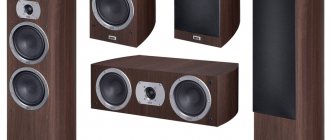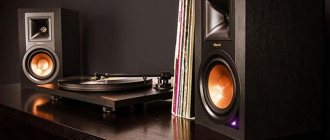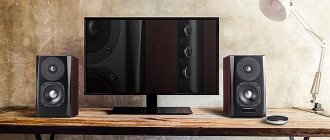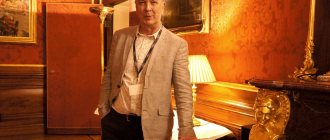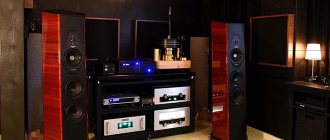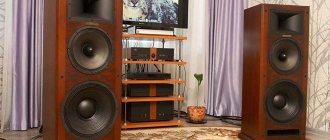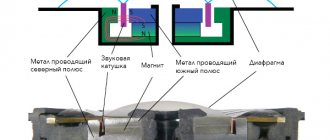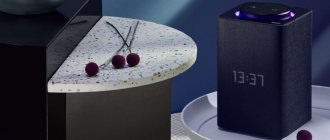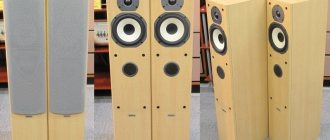Refinement of Aleks ID-507F SE “Amati” speaker systems
In general, I listened to the good Aleks ID-507F SE “Amati” acoustic systems (AS), which I bought about 10 years ago for $1000, for quite a long time until I got high-quality DACs and ULFs, with which the sound of these speakers began to seem unbearable: clearly “dirt” was heard not only in the midrange and high frequencies, but also an unpleasant hum in the low frequencies.
The characteristics plate is located on the rear wall of the speaker:
The question of replacing capacitors in crossovers arose in my mind almost immediately after purchasing the speakers, because when I looked at the filter board for the first time, I couldn’t believe my eyes: almost all of the installed capacitors were non-polar “electrolytes” from someone (except for one film capacitor with a nominal value of 0. 47 µF for the tweeter, connected in parallel again to the “electrolytes”):
I even wrote a letter to acoustics developer Alexander Yan-Belyaevsky with the following question (literally): “Does it make sense to replace these capacitors with, say, Nichicon ES non-polar electrolytes, or MCap Supreme polypropylene capacitors?” I’ll leave the respected developer’s answer here without comment (the author’s spelling and punctuation have been preserved, I’ve just removed some embedded quotation marks): “The acoustics use Japanese audio paper-film capacitors from a branch of the ELNA company. They look like electrolytes. In fact, these are only banks. The capacitors themselves are tape-film in paper and placed in aluminum cans to protect them from external high-frequency interference. The capacitors are marked No Polariti or NP, which means non-polar, non-electrolyte capacitors. There are no pros and cons signs either. There are no electrolytes in acoustics!!! Nichicon ES cannot be used in acoustics, they do not sound and they are unstable in operation. The leads are huge. They grab everything. You can install MCap, but they are very large and expensive. They will sound but no better than the Japanese ones that cost the ELNA branch. But you can have some fun. Suddenly it will be better. To make it better, you need to change the acoustics to a higher-class EVERLY model.”
And so I finally matured and decided to “have fun” and modify the speakers in order to use them for their intended purpose, and not just as a beautiful stand. To begin with, I removed the crossovers and speakers, and drew a circuit diagram of the speakers:
Position designations and values of resistors, capacitors and inductors are written on the crossover board, and speaker resistances were measured with a multimeter and may differ slightly from actual values. It was decided to change all the “electrolytes” in the midrange and high-frequency links (C1, C2, C6, C7, C8, C9, C10) with “film”, leaving them only in the low-frequency link (C3..C5), since their replacement is realistic will not be noticeable. I chose to replace inexpensive Chinese PAPRI capacitors, which have a fairly wide selection of ratings and are not very large in size. The option of using good domestic KZK capacitors was also considered, but I refused to use them, since the cost of modifying the speakers would have increased by about 2.5 times. I replaced three “electrolytes” C1, C2, C7 with two PAPRI 40+47 µF capacitors, “electrolytes” C6, C8 with PAPRI 10+3.3 µF, respectively, and as C9 and C10 I used the K73 I had in stock -11 2.2 µF and Mundorf MCap Supreme 1 µF respectively.
Addition: subsequently (for the sake of experiment) the polyethylene terephthalate capacitor C9 type K73-11 was replaced with a polypropylene MKP “WEAH”, as a result the sound at HF became noticeably softer, from which we can draw an unambiguous conclusion: K73-11 capacitors are not suitable for good sound (although On some forums you can find the opposite statement). Also, instead of cement wire resistors R3, R2, glass wire resistors Vishay (Draloric) G204 4.7R 7W 2% were used, which also had a very beneficial effect on the sound.
Refinement of the crossover boards began with the dismantling of replaceable electrolytic capacitors:
and instead of 4 screws securing the board, hexagonal brass posts M3 with a height of at least 25 mm are screwed in - to install the upper additional board with new capacitors (I used two posts each: the bottom ones are 8 mm long - they had sufficient thread stroke for screwing in the shank "male" in plastic, and the upper ones - 20 mm long - ordinary, with a short male thread). I added B-7000 glue to the holes before screwing in the posts. I used the same glue to fix capacitors on new boards made from single-sided fiberglass 1.5 mm thick using the LUT method:
For additional rigidity, the capacitors on the new boards are secured with ties. Capacitors are installed on both sides (capacitors with a nominal value of 3.3 μF are located at the bottom).
In place of the dismantled “electrolytes”, wires are soldered onto the “old” crossover boards to connect to the upper board:
At first it was planned to attach these wires to the top board through terminal blocks with a pin pitch of 3.5 mm, but it turned out to be easier to solder them to the pads on the bottom of the new board. As a result of fixing the elements with B-7000 glue, a rather monolithic structure was obtained:
To secure the top board, 6mm long M3 screws with washers were used.
____________________________________
Additions to improvements throughout the article
1. View of the top board with a polypropylene capacitor C9 type MKP with a nominal value of 2.2 μF, installed instead of K73-11:
2. View of the main board with vishay (Draloric) G204 4.7R 7W 2% vitrified resistors in the crossover of the HF and midrange sections (green below in the photo):
____________________________________
Before installing the crossover boards in their places, it is necessary to perform additional damping of the speaker cabinet to dampen unwanted vibrations and hum. The standard padding polyester attached inside had to be temporarily removed in order to cover all the walls of the case from the inside with automotive sound-absorbing adhesive material 8 mm thick (two sheets were enough).
After this, the padding polyester was returned back and secured to the side walls from the inside with a small amount of Moment-Crystal glue.
The considered design has one drawback: the height of the fully assembled filter unit (together with the additional board) does not allow it to be installed through a rather small hole at the back of the speaker. Therefore, before installing the filter unit, it is necessary to release the upper additional board by unscrewing the screws that secure it. The boards can then be inserted one at a time into the hole at the back, but the top board will have to be secured with screws through the front holes for the two lower woofers. To prevent the screws from falling off when screwing the board, you need to use a magnetic Phillips screwdriver or fix the screws on the tip of the screwdriver with pieces of 3M double-sided tape (I used the second option). I had to tinker, but it worked!
Step-by-step installation of the boards is shown in the following photographs.
Rear view of the speaker - all wires are soldered to the boards, but the screws securing the top board are removed:
The top board with new capacitors is inserted into the hole at the back of the speaker, and the standard board is almost in place (all that remains is to “tighten” it and screw it to the speaker body):
The standard board is fixed to the back of the speaker body, and the top board is not yet secured with screws from the inside:
The top board is secured with screws from the inside:
Everything is in its place, all that remains is to close the crossover with padding polyester:
Since the wires were initially soldered (!) to the speaker blades, it was decided to make the connection in a human way - using terminals in the form of socket connectors 4.8 mm and 2.8 mm wide (the corresponding pin connectors included in the kit were not useful) :
I would like to draw your attention to the fact that the positive lobes of all speakers except the tweeter are wide (4.8 mm), and the positive lobe of the tweeter is narrow (2.8 mm). The lobes of the tweeter speaker are fixed on a rather “frail” plastic plate that easily melts when heated with a soldering iron, so unsoldering the wires from the speaker and subsequent connection of the terminals should be done with great care.
After installing the crossovers and all the speakers in their places, I was very eager to check the result of the speaker modification: was it all in vain? It turned out that it was not in vain. Speaker systems began to sound much softer and cleaner. The unpleasant hum in the low frequencies has disappeared, and the midrange and high frequencies have become much more detailed. I want to listen to these speakers!
Attached is an archive file with a drawing of an additional printed circuit board (in the format of the Sprint Layout 5 program) for the capacitors I used.
About the prospects of the 360 Reality Audio format, photographs of ears and the well-forgotten old
The appearance of the new 360 Reality Audio format at the beginning of this year at CES was expected, and therefore did not have the effect of an information bomb exploding. Among potential end users, the format was met rather coolly and was of interest mainly to specialists. Meanwhile, having become acquainted with it and understanding what it represents, we can talk about the great future of this development. Amazon Music, Deezer, Tidal and nugs.net have already shown serious interest in the format.
A month ago, the services confirmed information that they intend to broadcast music in a new format. I believe that for streaming platforms the use of traditional two emitters played a role, instead of the large number of sources that are necessary for correct playback when using the competing Dolby Atmos format. But is this format really new and what can we expect from it in the future? Below the cut I talk about 360 Reality Audio and talk a little about its immediate prospects.
New for those who didn’t know about binaural recording
So, to call SONY’s development something fundamentally new is a lie, since the theoretical and technological basis for its creation appeared quite a long time ago.
Anyone who has ever encountered binaural recordings will instantly recognize them after listening to the demo track on the SONY website. For comparison, you can use one of the virtual barbershops created using binaural recording. For example, this one (you can evaluate it using headphones): The main advantage of 360 Reality Audio is the ability to accurately localize many KIS (apparent sound sources), while in most binaural recordings one or at most two instruments are accurately localized, the localization of the rest is often less clear. Another feature of the technology is that it takes into account the individual characteristics of the listener’s auricle. The function is implemented thanks to the Headphone Connect application from SONY (guaranteed to work only on compatible devices). To analyze the ears, it is enough to photograph them. Interestingly, there have also previously been projects that take into account the features of the auricle, for example, the startup Nura, which used a test signal and reflection analysis.
Having “learned” about the shape of the auricle from a photo, Headphone Connect creates an individual profile and allows you to tailor playback to a specific user. Thanks to all of the above, SONY offers a realistic sound picture with the exact location of many phantom sources in a stereo panorama.
Compatibility and devices
If we talk about wireless speakers and headphones, then to use the format you will need mandatory hardware support, i.e.
decoder from SONY. Currently, the only compatible fixed wireless device is the Amazon Echo Studio, which will decode the signal from Amazon Music HD. The speaker will go on sale on November 7th. It is important to understand that the use of new technology is only possible with a paid subscription. The manufacturer writes that the vast majority of modern headphones will work sanely with the new format. To play you will need Deezer, Tidal or Nugs.net for your operating system. Amazon Music Unlimited does not yet support the technology.
As mentioned, when used with Headphone Connect compatible headphones, you can create a custom profile optimized for your specific ears. It should also be noted that many users question the effectiveness of this function - they simply do not feel the difference between the sound in their own profile and a profile optimized for another person.
In the future, SONY plans to implement hardware support for 360 Reality Audio on Alexa devices as well as on those that will support Google Chromecast. It is expected that in the future, support will be implemented in the basic functionality of mobile chips from Mediatek I, NXP Semiconductors, Qualcomm. In addition, SONY announced a collaboration with Fraunhofer IIS, which will make 360 Reality Audio available to music creators.
Regarding the prospects of technology
Despite the fact that there is nothing fundamentally new in binaural recording, the format does offer users higher fidelity and more realistic localization of phantom sources.
And considering that 360 Reality Audio is not being practiced by just one and a half enthusiasts (as was the case with binaural recordings before), but by such a giant as SONY and large streaming services, we can count on this format becoming a new standard. Initially, it will only be niche, but given the difference with traditional stereo, which is noticeable to anyone, it will gain popularity within 5 to 7 years. Also, it is unlikely to be able to displace Dolby Atmos, since the latter is designed more for home theaters than for music playback. Moreover, effects relatively comparable to Dolby Atmos, with 360 Reality Audio, are only possible with headphones (which the developers primarily rely on), which is guaranteed to reduce the audience.
The process of integrating the format into the studio process has already begun. According to Sony, more than 1,000 tracks in the new format have already been prepared for streaming services, including Mark Ronson, Pharrell Williams, Billy Joel and Jeff Beck.
I also believe that in Russia the format will become popular and widely used much later than it will happen in the USA and Western Europe. This will happen due to the fact that streaming services primarily count on Western audiences, whose tastes differ significantly from the musical tastes of Russians. As usual, I will be grateful for your opinions on the prospects and usefulness of the format and technology in the comments.
Jeans
We sell electronics for high-quality sound reproduction. It is likely that devices supporting 360 Reality Audio will appear in our catalog in the near future.
Acoustics Aleks Gold-2
- Manufacturer: ALEKS Digital Technology inc.
- Made in not specified
- price, rub. 15000
- www.aleksaudio.ru
Externally, Aleks Gold-2 resembles retro monitors from the early eighties of the last century rather than modern speakers. In today's world of total savings on trifles, such a definition can be considered a compliment.
These are quite large and heavy shelf holders with a “closed box” design. The two-way design uses proprietary dynamic drivers. The tweeter has a one-inch dome made of silk with a special rubber impregnation. This provides it with exceptional lightness and high resistance to extraneous resonances. The midbass driver diffuser is made according to classical canons. Its base is pressed cellulose, onto which a proprietary compound is applied, which imparts the necessary sound properties.
The crossover filter is for first-order systems; it is mounted mounted from selected components (it’s a pity that the manufacturer does not indicate the crossover frequency). Internal installation here is carried out using a special cable made of oxygen-free copper of high purity with the addition of silver and indium. Gold-2 cases can be safely called monolithic. In addition to very serious internal damping using clever materials, high-density wood materials and even solid wood elements were used in the production. Externally, the speakers are finished with very high quality American walnut veneer.
The Gold-2 has only one pair of terminals for connecting to an amplifier, but they are very solid and massive - the kind found, perhaps, only in very expensive acoustics.
From the first minutes of listening, these monitors captivate with their transparency and purity of sound. The mid-frequency band is reproduced in detail and naturally - it is timbre-rich and moderately informative. I was very pleased with the quality of the connection between the woofer and the tweeter; there is no noticeable seam to be detected by ear; the overall impression of the speaker is reminiscent of good broadband systems.
There are no complaints about the reproduction of the attack - the jerk of the bass guitar string is distinct and elastic. In general, the quality of the bass register here is very high. The only thing that Gold-2 can be reproached for is that the bass depth is not always sufficient. From systems of this size you can’t help but expect more thorough performance at the lower end of the range, but don’t forget that these are closed systems.
The upper frequencies here are very rich, the trebles are clear and extremely specific. However, sometimes the tweeter radiation is perceived as a little intrusive, unnecessarily attracting attention to itself. Here it is worth playing with the selection of speaker cables or experimenting with turning the speakers around their axis.
Aleks is in perfect order with spatial indicators. For its price, the sound stage is built simply exemplary. The localization of virtual sources is stable throughout its entire length, and several plans can be confidently read in depth. The overall scale is excellent and stable at any reasonable volume levels.
PLEASED
Detailed and informative sound in general, high quality workmanship.
DISAPPOINTED
Sometimes the top is too intrusive, the bass is modest in depth.
Bookshelf speaker systems 19,900 - 37,800 rub.
- Aleks Gold-2 15,000 rub.
- Audio Pro Wigo Wi-130 9000 rub.
- Energy CB-20 14,000 rub.
- KEF iQ10 17,000 rub.
- Paradigm Mini Monitor V.6 RUB 13,990
- Tangent Clarity 4 8335 rub.
- Wharfedale Diamond 10.2 RUR 6,850
- Measurements
share
Tags: AleksRecommended
